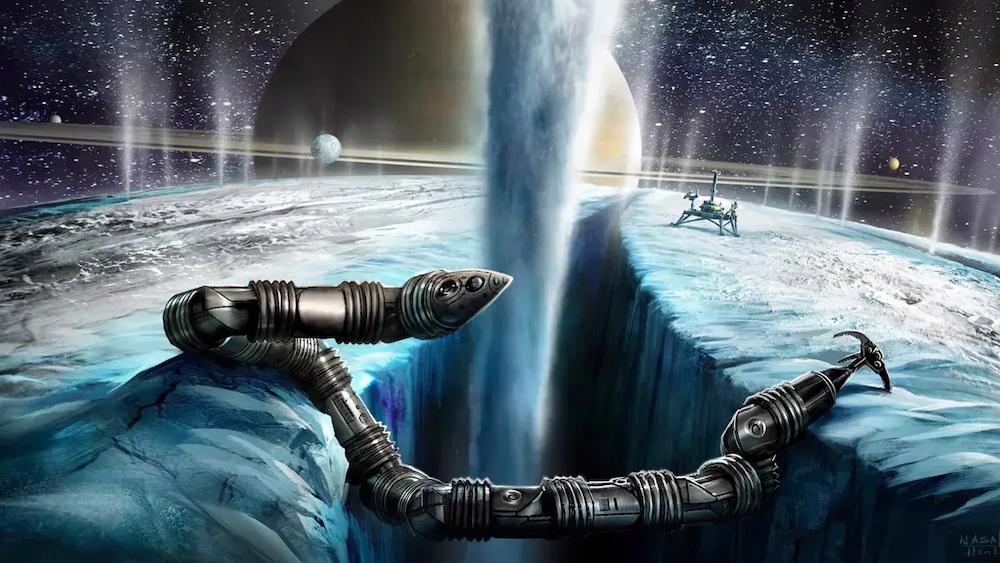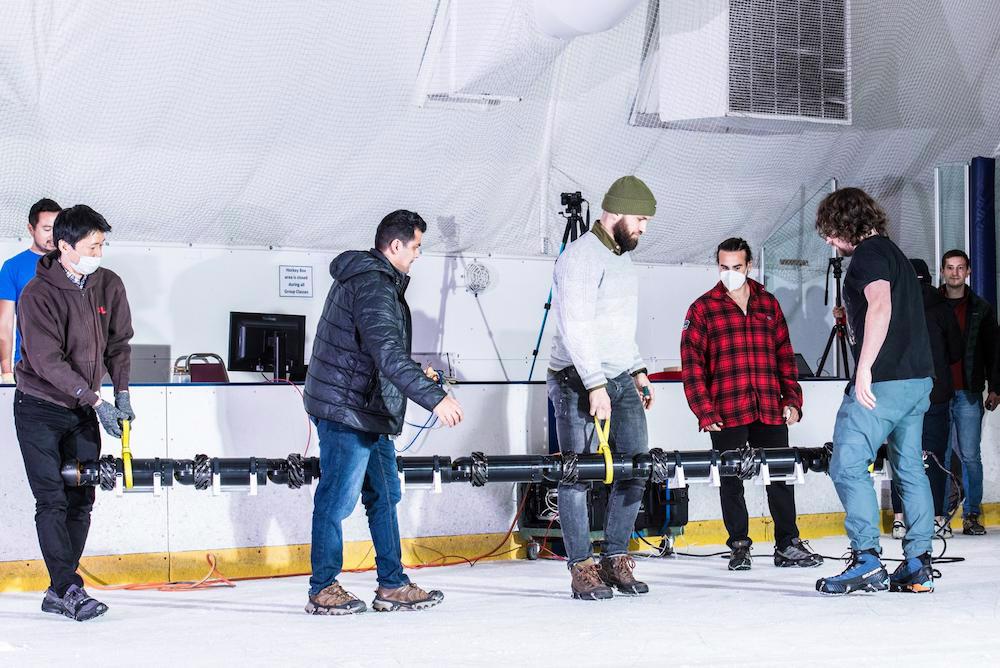NASA Plans to Terrify Extraterrestrials With Giant Robotic Snakes

One of the scariest science fiction creations of all time comes from the fertile mind of Frank Herbert, who gave us the “Dune” series of novels and the gigantic snale-like creatures of the desert planet Arrakis known as the sandworms. Their arrival spelled terror and a potentially gruesome death for melange (“the spice”) hunters who knew that the sandworm was protecting the valuable drug produced by its own larvae. While we have only encountered sandworms in our minds and on the movie screen, NASA has unveiled plans to possibly terrorize real extraterrestrials with a similar creature – robotic snakes. Does NASA know that sandworms, melange and Arrakis are all fictional? Have its mad robotics scientists considered the consequences if aliens somehow manage to overpower one of their robotic snakes and reverse-engineer it? Does it sound like we’ve partaken in a bit too much melange?
One of the larger moons of Saturn is Enceladus. Because it is so reflective, astronomers suspected it was covered with ice, making it a good location to potentially find life forms. For that reason, the moon was visited by both Voyager 1 and Voyager 2 when they flew by Saturn in 1980 and 1981 respectively. Voyager 1 showed Enceladus to have a highly reflective surface devoid of impact craters, indicating it was a recent formation. Voyager 2 passed much closer and found an older, heavily cratered area in the northern latitude region, and a lightly cratered region closer to the equator – these discoveries were a surprise to astronomers and inspired them to send the Cassini spacecraft, which entered orbit around Saturn on July 1, 2004. Enceladus was a prime target of Cassini and received several flybys which showed water vapor with traces of simple hydrocarbons venting from the geologically active south polar region. In 2015, Cassini flew within 49 km (30 miles) of the surface of Enceladus and directly through a plume which confirmed the presence of molecular hydrogen (H2). All of that, plus evidence of hydrothermal activity on the floor of Enceladus’ ocean means it has the water, nutrients and organic molecules to make it one of the best places in the Solar System to search for extraterrestrial life. All we need is a suitable robot to send to explore its surface, ocean and anything else there.

“The EELS system is a mobile instrument platform conceived to explore internal terrain structures, assess habitability and ultimately search for evidence of life. It is designed to be adaptable to traverse ocean-world-inspired terrain, fluidized media, enclosed labyrinthian environments and liquids.”
Introducing the appropriately named Exobiology Extant Life Surveyor (EELS) system recently, NASA’s EELS is like nothing we’ve sent to the surface of Mars, Venus, asteroids or the Moon before, nor is it anything like the wheeled rovers or bipedal robots we’ve imagined would be sent to planets and moons beyond them. With Enceladus and Jupiter’s moon Titan (which has a thicker ice crust) in mind, the research and development staff at NASA’s Jet Propulsion Laboratory in California rejected the rover and the humanoid robot designs and settle on the snake … or eel, since it would need to swim in an ocean as well as across a solid surface. The key to selecting the snake design was the water plume that Cassini flew through.
“Cassini data indicates that Enceladus has a liquid ocean under its icy crust. The plumes erupting from its surface are conduits directly to liquid water, potentially making this the easiest path to a habitable liquid ocean.”
While a mole or a ferret or a rat design could also crawl down an ice hole made by a hot water plume, an autonomous robotic snake proved to be the best way to traverse across the crevice-filled surface to get to the hole. Why? Only a robotic snake can quickly change the shape of its entire body to conform to new terrain on both sides of the hole’s opening. On the surface side, EELS is equipped with rotating grips and screws that allow it to crawls around, over and through hills, valleys, crevices, walls, holes and other obstacles in encounters in a wide variety of surfaces – sand, dirt, rock, ice, and perhaps even some not yet anticipated. To achieve snake-like slithering, EELS is made of independent identical segments containing actuation and propulsion mechanisms as well as the power and communication electronics to drive them. That’s right … independent segments. (A simulated video of what EELS might look like in explooring mode can be seen here.) While the press release does not address it directly, it seems NASA has already planned for EELS to act like some real snakes and worms which can be cut into parts and the parts continue to live on and function. However, it is when the robot snake gets to the plume entrance that its design really shines.
“EELS uses first-of-a-kind rotating propulsion units that act as tracks, gripping mechanisms, and propeller units underwater, enabling the robot to access a plume vent exit and follow it to its ocean source.”
This robotic moon exploring snake is water-tight and can swim to and through the ocean of Enceladus (and other moons and planets), performing the same probing, viewing, experiments and analyses that other robotic devices can only do on the surface. NASA and JPL are confident of EELS’ abilities because it has already been tested in Canada’s Athabasca glacier and Mount Meager volcano under the direction of the Royal Canadian Geographical Society and National Geographic who used their vast experience in these harsh environments to thoroughly exercise the robotic snake.

Will EELS really terrorize life forms on other moons or planets? That depends on how large they are. In the prototype, the segments are about 10 (4 inches) in diameter and 50 cm (20 inches) long, which would make a prototype of 10 segments about 500 cm or 16.4 feet long. That’s not sandworm size but it could be imposing to surface or underwater life forms. And, while EELS has the capability to extract and hold samples of solids, liquids and whatever else it encounters, it doesn’t have that gaping sharp-toothed mouth of a sandworm.
Could a NASA robotic sandworm be in the plans? Well, one of the many goals of space travel is to mine other space objects for minerals. What better way to penetrate and drill through these moons, asteroids and planets than with a robotic replica of nature’s boring devices but enlarged to sizes far beyond pythons and giant worms? For now, we know that Enceladus and Titan are prime targets for upcoming missions by NASA, ESA and other space organizations and the robotic worm is proven and ready to go.
And if the first of the EELS finds spice? What would Frank Herbert recommend we do?




